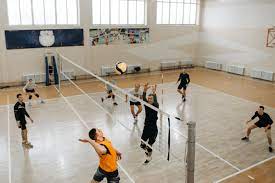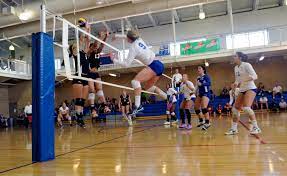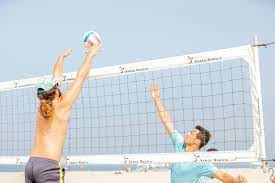Introduction:
Blocking in volleyball is one of the crucial aspects of the game. In blocking, the players attempt to stop the opponent’s attack by obstructing the ball at the net. But as a volleyball lover, we may get a doubt like can you block over the net in volleyball? In this article, we will discuss the FIVB rules, common mistakes while blocking over the net, and different techniques of blocking over the net in volleyball. So, let’s get started.
Can You Block Over The Net In Volleyball?
Yes, you can block over the net in volleyball if FIVB blocking rules and conditions are met. For the block to be legal, the opposing team has to complete their attempt to return the ball over the net.
When you jump to block, your hands and arms can legally cross the net, but make sure that no other part of your body apart from your hands or arms penetrates the opponent’s side of the court. If you do so, it is illegal and the opposite team is awarded a point.
It is legal to touch the ball beyond the net only if it does not interfere with the opponent’s play before or during the latter’s attack hit.
To execute a legal block, you must time your jump and position your hands above the net without crossing the vertical plane.
To Know More About The FIVB Rules, Click Here
Why Volleyball Players Block Over The Net In Volleyball?
A volleyball player blocks over the net to stop the other team’s attack and keep the ball from landing on their side of the court. It’s like building a wall at the net to make it harder for the opponents to score points.
By doing this, the blocker not only defends the net but also makes it tough for the other team to hit the ball where they want. A good block can mess up the opponent’s game plan, force mistakes, and give support to their teammates in the backcourt. So, blocking is a key move to play strong defense in volleyball.

Common Mistakes in Over-the-Net Blocking in Volleyball
Poor Timing
One of the most common mistakes players make while blocking over the net is mistiming the jump. Timing is everything in volleyball, and if you jump too early or too late, your block loses its effectiveness.
It’s essential to set up your jump with the attacker’s hit to maximize your chances of deflecting the ball.
Inconsistent Hand Placement
Another frequent error is having inconsistent hand positioning. A successful block requires proper alignment of your hands and arms.
Failing to maintain a strong, well-formed block with both hands can lead to the ball slipping through the gap or deflecting in unintended directions.
Overreaching
Overeager players might make the mistake of reaching over the net too soon.
This not only risks committing a violation but also leaves a gap between the blocker’s hands and the net, making it easier for the attacker to find an opening.
Ignoring the Hitter’s Approach
Some blockers focus solely on the ball and neglect to observe the hitter’s approach.
Understanding the opponent’s timing, position, and hitting tendencies can significantly improve your chances of making a successful block.
Lack of Communication
Volleyball is a team sport, and effective blocking requires coordination. Players often make the mistake of not communicating with their teammates about who should block which hitter.
This miscommunication can lead to confusion, leaving gaps in the block or multiple players going for the same ball.
Not Penetrating the Net
A common error is failing to penetrate the net with the hands and arms. A strong block not only involves getting your hands on the ball but also pressing over the net to create a solid barrier.
Players who don’t penetrate enough risk having the ball sneak through or deflect off their hands.

Ignoring Footwork
Effective blocking starts with proper footwork. Some players make the mistake of not positioning themselves correctly before the jump, leading to an unstable and less effective block.
Solid footwork ensures a strong foundation for a successful block.
Ignoring the Opponent’s Setters
Successful blocking isn’t just about stopping the hitter; it’s also about anticipating and blocking the setter’s options.
Players may make the mistake of solely focusing on the hitter, neglecting the potential quick sets or dumps by the opposing setter.
Watch This Video to Learn More
Key Techniques for Over-the-Net Blocking In Volleyball
Penetration and Timing
Successful over-the-net blocks depend upon the timing and penetration. You must time your jump perfectly to reach the highest point possible. Effective penetration involves extending the arms and hands over the net at the right moment disrupting the direction of the ball.
Sealing the Net
A well-executed block involves not only reaching over the net but also “sealing” it. This means ensuring no gap between your hands and the net.
Reading the Hitter
Anticipating the opponent’s intentions is a crucial skill in volleyball. A skilled blocker learns to read the hitter’s body language, enabling them to position themselves effectively and react swiftly to block the ball over the net.
Conclusion
In summary, yes, you can legally block over the net in volleyball as long as you follow FIVB rules. Blocking is a key defense move, aiming to stop the opponent’s attack. However, timing and proper hand positioning are crucial to avoid common mistakes like mistiming the jump or overreaching.
Effective blocking involves not only stopping the hitter but also anticipating the setter’s moves. By perfecting these techniques and addressing common errors, players can improve their over-the-net blocking skills, contributing to a stronger defense on the court.
How do you think mastering over-the-net blocking can shift the momentum in a volleyball game? Please answer in the comments below.
What is an over-the-net violation in volleyball?
An over-the-net violation in volleyball occurs when a player reaches over the net before the ball has crossed, resulting in a point for the opposing team.
Can you reach over the net?
In volleyball, players are not allowed to reach over the net before the ball has crossed to the opponent’s side.
Does a block count as your three touches?
No, a block does not count as one of the three allowed touches in volleyball. After a block, the team still has three more touches to play the ball.
Can you block and hit in volleyball?
Yes, in volleyball, players can both block at the net to defend against the opponent’s attack and subsequently hit the ball as part of their team’s offensive play.
Can you set over the net in volleyball?
Yes, in volleyball, a player is allowed to set the ball over the net to a teammate for an attack, provided it is done cleanly with open hands and within the rules of the game.
